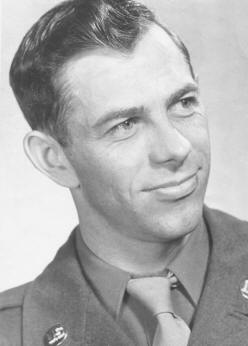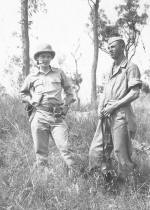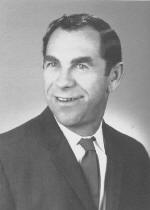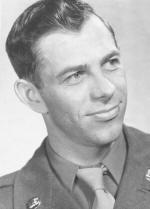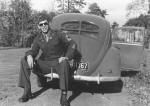|
We need your help to keep the KWE online. This website
runs on outdated technology. We need to migrate this website to a modern
platform, which also will be easier to navigate and maintain. If you value this resource and want to honor our veterans by keeping their stories online
in the future, please donate now.
For more information, click here.
|
|||||||||||||||
 |
|||||||||||||||
| Back to "Memoirs" Index page | |||||||||||||||
Major James F. MaloneTemple, Texas - "Seeing my first dead man in this war from my Battalion hit me hard and affected me, even though I had seen many of our dead in World War II. I had known this one. " - James Malone |
|||||||||||||||
Memoir Contents:
Korean War MemoirsWar Breaks OutAs the news of our involvement in far off Korea spread to the United States public in 1950, we had three or four reserve officers on two-week's active duty with our engineer company at Fort Lewis. As the company supply sergeant, I had some paperwork for my company commander's signature. I walked into the officers’ session, overhearing one of the reserve officers--thinking that he was wise, observe that he did not expect much from it all. I so well recall my company commander's comeback response as he thereupon got up, opened his office window screen, and spat his snuff chew outside, reminding the reserve officer that earlier he had been in the Sixth Division in Korea and that he was scared s---less to go back. Not too long afterward in Korea, he was awarded the Distinguished Service Cross and was medically evacuated. Soon there was a big Sunday afternoon radio news announcement that our Second Division was to be sent to Korea. This news actually caught us flat-footed, with me technically AWOL. As a newly-appointed warrant officer, I was to start a 15-day leave the next day. Another officer was to sign me out, yet here I was in Boise, Idaho. After telephoning in, I drove over the distance--which required driving all that Saturday and Sunday with my wife and two daughters. We returned to Fort Lewis by 6 a.m. that Monday, but I was completely physically exhausted. Preparations for OverseasFrom a training status our division rapidly prepared for overseas movement from Ft. Lewis. Assigned to my new job in Battalion Supply, we had to work doubly hard not only equipping our own Battalion, but also the division, with such engineer supplies as grease pencils, clear acetate and maps. While still preparing for overseas movement from Fort Lewis, our units were supplied with and fired the new 3.5-inch AT rocket launchers on post ranges. One job of mine was to requisition a basic load of mines for the division. Our personnel shortages were made up by transfers mostly from the 5th Engineer (C) Battalion. Strangely, our battalion's two West Pointers did not go with us to Korea. The Army's opinion seemed to be that Engineer officers' long-term schooling was more important than fighting a war like the rest of us. Our division shipped out in three elements, generally the three regimental combat teams, on 17 July 1950 on the USNS Patrick. The USNS Morion carried the 9th RCT. Other ships used were the California Victory, the Sultan, Funston, Freeman, Darby, Towie, Mormacsea, Arcadia, New World, Linfield, Eiko, Greely (05Aug-20Aug50), Stewart, Robinhead, Mitchell, Joplin, Rutgers, Wake Forest, and the Collins. These ships followed as soon as we out-loaded. We were in the last ships to leave. En route we fired all of our weapons from the ship's fantail at our garbage. As we were out-loading on our troop transport in Tacoma, a very officious intelligence major rushed up to Col. James Tully, our Division Chief of Staff, and told the Colonel to cover up the division patch on his shoulder with tape. Colonel Tully told the major to take the patch off and "stick it up your _____." Colonel Tully was a very senior infantry colonel and was very crusty. Just before our off-loading in Pusan, members of an advance party came onboard our ship to brief all of our officers in officers' call. At the conclusion, this same major jumped up to yell, "Gentlemen, nothing said in here is to be repeated outside." Again Colonel Tully squashed him with "H___ S___ officers. Go tell your troops. That's your job." Later he was medically evacuated very early in the fighting. On the sea trip across, Chief Warrant Officer Kelley in Division IG repeated a story of his earlier service in Korea. When a lieutenant returned to his BOQ room, he found two slicky boys (thieves) therein rifling his room. On seeing him, they split. One went out the window to the left and one to the right. With his .45, he got both. Kelly relished that part of his story where the Lieutenant said that he had to change hands. In a Combat ZoneAs soon as our equipment was unloaded, we formed a march convoy virtually from the docks driving north to Miryang, then to Yongsan, winding up in the same valley that the Marine Brigade Headquarters was also moving into. On the drive up, we kept passing Marine trucks towing Howitzers. Their cowboy-like drivers had missed the top of the dike and driven them off the very narrow road atop the levee separating rice paddies. Their trucks were off first one side, then the other. Our own drivers were more cautious and had better luck. This was both our and the Marines' first afternoon in Korea. Much later that first afternoon, we watched the Marines using a helicopter to put security outposts on top of the surrounding hills. Other Marines lately have argued with me that this did not happen until a couple of years later, but we definitely watched it that first evening. I don't remember how long we were neighbors to the Marine Headquarters, but it continued for only a very few days while we did various engineer tasks. Then on 02 September 1950, to stop the North Koreans our Battalion was committed as infantry at Yongsan. That afternoon I was sent far to the rear to Miryang to get ten truck loads of ammunition, but was not told exactly what items to get. Our Division Ammo officer, a captain located at the Corps Ammo supply point, greatly assisted me in the preparation of my requisitions. The other Ammunition Supply People (ASP) there moved very slowly as if still in peace time. Eventually I had all of my trucks out-loaded and left about 1900 to rejoin my Battalion. Still later, about 2300, we were driving along the Division Main Supply Route with only our blackout lights when instantaneously a 155mm battery fired over our trucks and across the road. The muzzle flash and the resulting noisy crash deafened me, causing me to jump way up off the truck seat. Although I had been around artillery for years, this experience out of the dark startled me the most. About an hour later, I arrived at our greatly-reduced-from-its-engineer-status Battalion Headquarters. My drivers and I were told to just grab some sleep until daybreak. Then I sent my trucks out to the companies with the badly-needed ammo because during the night they had a very determined and prolonged infantry fight. The Battalion had many casualties that night. Early the next morning, one three-quarter-ton weapons carrier was driven in the fog from one of the companies with a soldier's body stretched across the hood. He had been killed by a grenade that splayed out all his intestines over his blackened body. Many years later, an interviewer was in deep shock because we had not taken the time to cover the body. This was the first step to a graves registration unit. Although the soldier had been in another company, we had seen him back at Fort Lewis in various parades, at sporting events, and other places like the branch post exchange. Seeing my first dead man in this war from my Battalion hit me hard and affected me, even though I had seen many of our dead in World War II. I had known this one. Later I had to provide trucks and watch while our trucks took a detail out to retrieve our dead. Our Battalion CO was so impressed that he promoted this Tech Sergeant in charge to Master Sergeant--even though this Sergeant had only been a Tech Sergeant for a few days. As a Warrant Officer I was customarily the passenger in our supply truck. I had the habit of holding the steering wheel while the driver lit up. While driving on the very crooked Korean roads over the steep hills, I soon found that I was endangering our vehicle. It was just too crooked for me to be able to steer from the passenger side. Bridging the RiverNext I was recalled to officer status and assigned to Company C. Late that same afternoon, 15 September 1950, I was sent out to make a bridge recon, taking my Assistant Platoon Sergeant, Sergeant Fields, and a Jeep driver with me. We drove to 38th Infantry Regiment Forward HQ, getting there about 2200. I asked the guard to awaken us at 3 a.m., but my request was overlooked. At 0430 I awakened myself and we drove on forward to Pugyong-ni near Changnyong, getting there just after daybreak. Some 38th infantry men were leaving their slit trenches on the hills north and south of the road and walking to the broad, sandy beach (300-400 yards wide) towards the river and joining us. There we found between ten and twenty North Koreans who had committed hari kari on the sandy beach. Had we been blundering around in the dark during our recon, we would have been in the middle of these NKVAs committing suicide, and thus in grave danger. Shortly I left and drove as fast as possible back to Battalion, getting there about 1000. The Battalion Commander was irritated at me because I was supposed to have been back by 0900. He then told me to go rearward to Division G2, where I reported and talked to the Division Chief of Staff. Then verbal orders went to our Battalion to bridge the river and to the 38th Infantry to cross it. The 38th did so by swimming it! Our Company C started to build our organic bridge set from our bridge platoon. A major problem was getting a rope highline across. Each time we tried to raise it, we snagged one or more North Korean bodies--all water-logged and the weight snapping our rope. After about six attempts we succeeded and started our bridge assembly. The 38th Infantry Regiment CO, Colonel Peploe, sat on a stack of our bridge components, impatiently swinging his leg back and forth as we did the lengthy bridging operations. We hadn't even finished our bridge when we were ordered to cross the unfinished bridge along with the 38th. Other 2nd Engineer "C" Company Battalion people finished the bridge. The race to use the bridge began with the 38th RCT being the first major element to cross the unfinished bridge. After crossing the Naktong and advancing many miles one other night in September 1950, my platoon of engineers was assigned the maintenance of a ford across a river. To do this we loaded and dumped rocks in the river. That entire day and night, elements of our 2nd, plus others--many from the 25th Division, forded this stream. To this day I do not know how many vehicles also crossed the stream. In late September I was sent on a recon of a railroad bridge. The trestle bents were propped up in all kinds of ways using rice bags and wooden posts, plus everything else the North Koreans had scrounged up. Facing this mess, I didn't know what to do and asked some South Koreans how many cars, including the locomotive the North Koreans had sent, crossed this bridge. They told me six or seven cars, so I reported back that the bridge would carry a locomotive and two cars. Later it so happened, for some unremembered reason, that I was again at this same bridge. A locomotive and a rail car came up carrying the Division Transportation Officer and my Company Commander, a real heel. This Company Commander looked at the bridge and flatly informed the Division Transportation Officer that the bridge would not carry the load. I said nothing then, but it so happened that I came home on the ship with that Transportation Officer, Captain Windebank. I told him why I had so reported. My shipmate then cursed and said the Division's route was changed because of this bridge. Otherwise we would have gone to Kunsan. During this time at mess times, every meal was spoiled by this Company Commander chewing out a newly-appointed warrant officer about the food. The food was what was issued and our mess people had done as good a job as they could. More MemoriesThere was the story of Tech Sergeant Jaurique, who was in a slit trench with a medic named Reid. During the night, Jaurique killed 27 gooks with a .45. When Reid was queried about it, he responded that no other Americans were around and he didn't kill any, although the bodies were there the next morning. To an engineer, driving a D-handle picket with a full swing on a sledge hammer is remarkable. I saw Jaurique in the black darkness as he drove the picket with one man holding a flashlight on the top and another holding the picket. (He had to be very trustful.) We got to and were held in Yongdong-po. The 1st Cavalry Division was racing to Pyongyang, and Task Force Indianhead raced with them for an intelligence mission. Meanwhile, I crossed the river to Seoul scrounging for engineer materials. I found several five-gallon cans of paint, etc., and was on my way back when I met a white Russian woman on the street who spoke good English. I talked to her for several minutes. Had I not had the Jeep driver, I might have gone AWOL for a few hours. The one vehicle in the division that our floating bridge would not carry was the low-bed dozer trailer because of the width of the trailer wheels. I don't know whether the Division ordnance company's tank recovery vehicle trailers could cross. Anyhow, we had to turn our dozer operators loose with a drum of diesel fuel to walk the dozer long distances like 75 miles, not normally ever done. I was then transferred to another engineer company, part of the 23rd Infantry RCT, and we moved to Haeju in early October. Haeju was way off to the northwest of Pyongyang. While there I wanted a bath, and had my Jeep driver drive me to a river. There, I stripped and bathed in the river with the ambient temperature of 40 degrees. My driver said that nothing would make him bathe in that cold weather. After our RCT left Haeju, it was later reported to be the center of much guerrilla activity. On one of our moves, for some reason I sent my road grader out front. It got ahead of even the Infantry Battalion Commander. Later I asked him about it. He said he didn't even mind the dust from the road grader because it set an even speed and it was fast enough for him. He seemed happy to have it as the Infantry Battalion CT lead vehicle. In the earlier days when roads over hills became one-way defiles because the road over the hill was not wide enough, we had Corps MPs regulating traffic through road blocks. Frequently on my supply trips I came across American youths of even 13 to 14 years of age whose parents had finally realized that their sons were in combat and might be killed. They had asked their Congressmen for the youths' return. At these defiles I saw over 15 of these very young people being sent home for discharge. Every one of these said, "I'll be back when I become 18." Later we moved to Sunchon village, which was near where the paratroopers had jumped earlier. There we built a timber trestle bridge across the river near Yongsan. Because I had worked at night, Captain White invited me to go along with his Jeep driver and radio operator. We drove east toward Wonsan, but I don't recall how far. On the way, we met some NKV infantry walking along the road, wearing the red star armbands. Foolishly we actually stopped for a few words with them. That was just plain stupid. We were lucky that nothing happened. I noticed at least two American .30 caliber machine guns that they had dropped by them alongside the road. On our return, we met our Battalion HQ recon party with three or four weapons carriers with machine guns mounted on the hoods and four or five Jeeps also with machine guns. What a contrast in our parties. On our afterward move to the north, we reported explosives in a cave along a very crooked road. Our Division was to hear more of this on the move back. This area was at the foot of what later was to be called the Gauntlet, where so many men were lost. We moved on north beyond Kunu-ri. I was sent on a recon through the First Cavalry Division area. We went on several more miles past Yongbyon (then called an ancient walled city--now the North Korean atomic works in today's news) to within about four miles of the Yalu. Engineer Company ReorganizationOn 26 November 1950, I was with my platoon working on an MSR when we got word to return to our Company area to reorganize as infantry. In an engineer company reorganization to infantry, the younger truck drivers replaced older men in the squads who then drove the trucks away. From long practice and many repetitions, we did this fairly fast. We were trucked across the Chongchon River, unloaded, and started out walking. My commander directed me to take my platoon towards the north. The place higher up on the hill he pointed to was under air attack by our own planes and smoke was rising from that area. I'll have to confess, I veered our route going to and up that lower hill to the south, joining the company just as they also arrived on top of the ridge. I imagine my route unduly perturbed my CO. Later I was told that he planned to pull us back after dark, but from the air attack of the area--then obviously held by the Chinese at that time. With us we had a medic aid-man who was a sergeant from the 1st Calvary Division who had been on a re-enlistment leave in the States. On his way back, he was in the Puget Sound area and was scrounged by the 2nd Infantry Division. Once when we were committed as infantry, we were summoned down from our hilltop position for chow. He was rifling the bodies of the enemy dead for loot when the mess steward grabbed him to help serve huge half-slices of peaches right out of Number Ten cans, without washing his hands. Every time I eat a peach, I remember that chow line. Another time I had the medic sergeant and others with me, as well as our trucks, as we searched a village for rice bags. Rice bags were far superior to our sandbags. Somehow I had information that the village had these. Almost fruitlessly, I asked the South Koreans to open a lock. They pleaded language difficulties so my medic sergeant said, "Lieutenant, let me show you." He took out his .45, and with one shot destroyed the lock. The South Koreans were amazed (as I'll admit I was, too). Under AttackA newly-assigned Lieutenant Duke was given my platoon and I was given one down a lower slope south towards Company "A". We dug in and about 2100 were under attack. Just before the onset of the attack, we had some trouble with some men sleeping in their slit trenches. I had to continually go around kicking one of them awake. During the attack, the Company Exec., 1st Lt. Bob Green, was hit in his right shoulder by a Chinese round. At times I believe we were under fire from our own tanks. Mortar, grenade, and much other small arms fire continued until almost 4 a.m. For some reason I was un-hittable that night and spent much of my time walking around out of a slit trench. My old platoon under the new lieutenant fell downhill on us sometime during the night. At about 0400, Captain White asked my advice as to whether we should fall back down on Company "A" and off the ridge top. I agreed. In hindsight I wish that I had thought of ordering fixed bayonets. As we fell back, I saw a sergeant who I was later told was a Forward Artillery Observer. He was wearing the outer shell of a parka, had his .45 out, and was circling around, standing in a hole. He was talking to himself saying, "They are all around us." By another hindsight, I should have gotten in with him and slapped him in order to bring him to his senses. I was otherwise engrossed with our more-or-less orderly fall back down the ridge. Now on reflection, I deeply regret neglecting this man. I was with the last of our people withdrawing. I got almost to the river's edge, but just couldn't bring myself to go into that frozen water. I then veered down alongside the stream and was carrying about twenty M-1 rifles when I found myself in a deep depression being fired at by at least 15 Chinese. Most of the ammunition being shot at me seemed to be tracer. As I told you before, I was un-hittable that night. I decided to run--not across the river, but continue down the Chong Chong river to the west. After a short run, I escaped out of the fire from the Chinese with only one M-1 rifle. Shortly thereafter I came to the village where our stripped-down combat Battalion HQ, the Infantry Battalion HQ, and a mortar company had been there earlier. Besides three or four other Americans whom I knew and had gathered up, we were the only people there. The silence in that valley was most eerie. I saw several pup tents with pairs of boots sitting in front, but NO ONE around! We crossed the valley to where a light recon tank had its engine idling and there was still no one around. Our Sergeant Carr got it in gear, drove forward against a weapons carrier, but then could not find reverse. We walked across a small creek and onto a road around the shoulder next to the river to another flat area next to the river where three or four of our heavy tanks were parked with minimum guards on duty. TrappedAfterwards we crossed the Chong Chong river and returned to our Battalion rear. Later I heard many of our senior NCOs had been hit from across the river by the Chinese just as they neared the south shore and supposed safety. We trucked back to Kunu-ri, just across the road from the 25th Division Quartermaster supply point. They had evacuated, leaving lots of supplies that we broke out and dug into. There were Number Ten cans of Queen Anne Cherries and peanut butter--frozen solid. We had nothing else to eat. I salvaged a footlocker filled with heavy woolen socks and found some other extra clothing for myself. Luckily I saw our S-2 changing out of his shoe pacs into regular boots and I did the same. The Battalion stayed with the vehicles. These eventually pulled out onto the road in the dark--as far as they moved that night. There is discussion as to who the Battalion Commander was at this time. I heard a rumor that the Battalion staff was all seen in a circle discussion. Although I had never believed this, apparently the Battalion colors were burned at this time. Separately the companies tried to walk to the west out of the trap. I was in the lead of our company, checking my line a couple of times. I then found I had only 17 men left. Afterwards my group walked through or around many Chinese road blocks, all with machine guns. Just before our initial encounter that night, we found ourselves in a group with some divisional lieutenant colonel. Then almost immediately we found ourselves in the midst of a huge group of Chinese and we were under attack by them. Finally Lieutenant Reed and I brought out about 350 stragglers, beginning with three of our Battalion mess stewards. One memory of the early morning hours is of three deer running across our front. There were several Jeeps and people down in the valley and one man wanted to go down to check them out. I refused him permission, as I was almost certain these were Chinese. It was a very hard walkout because we were enervated and exhausted having had no sleep in days. We were hallucinating. Our walk out was way to the west of the road that General SLA Marshall called "the Gauntlet." Eventually we staggered out into British hands. What a contrast their soldiers were, all neatly shaven and clean. We were so grubby, so filthy, and so far past exhaustion. Burning the Colors
Silver Star Citation
|
|||||||||||||||
Photo Gallery(Click a picture for a larger view) |
|||||||||||||||
|
|||||||||||||||
|
|||||||||||||||
 |
|||||||||||||||


